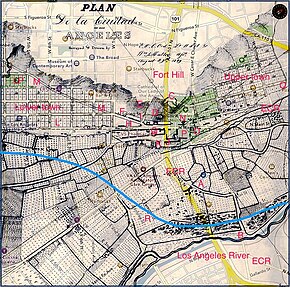History of Los Angeles
| Old Los Angeles | |
|---|---|
|
The written history of Los Angeles city and county began with a small Mexican town that changed little in the three decades after 1848, when California became part of the United States. Much greater changes came from the completion of the Santa Fe railroad line from Chicago to Los Angeles in 1885. Immigrants flooded in, especially white Protestants from the Midwest. Los Angeles had a strong economic base in farming, oil, tourism, real estate and movies. It grew rapidly with many suburban areas inside and outside the city limits. Hollywood made the city world famous, and World War II brought new industry, especially high-tech aircraft construction. Politically the city was moderately conservative, with a weak labor union sector.
Since the 1960s growth has slowed—and traffic delays have become famous. LA was a pioneer in freeway development as the public transit system deteriorated. New arrivals, especially from Mexico and Asia, have transformed the demographic base since the 1960s. Old industries have declined, including farming, oil, military and aircraft, but tourism, entertainment and high tech remain strong.
By 3000 B.C. the area was occupied by the Hokan-speaking people of the Milling Stone Period who fished, hunted sea mammals, and gathered wild seeds. They were later replaced by migrants — possibly fleeing drought in the Great Basin — who spoke a Uto-Aztecan language called Tongva. The Tongva people called the Los Angeles region Yaa in Tongva.
By the time of the arrival of the Spanish in the 18th century A.D., there were 250,000 to 300,000 native people in California and 5,000 in the Los Angeles basin. Since contact with Europeans, the people in what became Los Angeles were known as Gabrielinos and Fernandeños, after the missions associated with them.
...
Wikipedia

